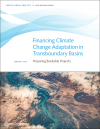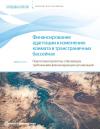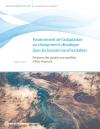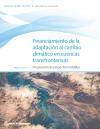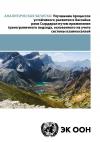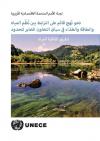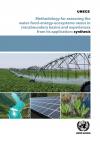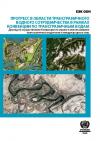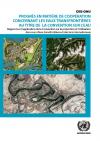Publications
Displaying Results 81 - 100 of 537
- English
New publication supports transboundary basins in preparing bankable project proposals for climate change adaptation
Water, climate and finance know no borders- which brings challenges and opportunities: The majority of freshwater worldwide flows in transboundary basins and most climate change impacts are felt through the water cycle. Transboundary cooperation in climate change adaptation is
- Pусский
New publication supports transboundary basins in preparing bankable project proposals for climate change adaptation
Water, climate and finance know no borders- which brings challenges and opportunities: The majority of freshwater worldwide flows in transboundary basins and most climate change impacts are felt through the water cycle. Transboundary cooperation in climate change adaptation is
- Français
New publication supports transboundary basins in preparing bankable project proposals for climate change adaptation
Water, climate and finance know no borders- which brings challenges and opportunities: The majority of freshwater worldwide flows in transboundary basins and most climate change impacts are felt through the water cycle. Transboundary cooperation in climate change adaptation is
- Español
New publication supports transboundary basins in preparing bankable project proposals for climate change adaptation
Water, climate and finance know no borders- which brings challenges and opportunities: The majority of freshwater worldwide flows in transboundary basins and most climate change impacts are felt through the water cycle. Transboundary cooperation in climate change adaptation is
- Pусский
The Sendai Framework for Disaster Risk Reduction 2015–2030 was adopted at the Third United Nations World Conference on Disaster Risk Reduction (WCDRR) in Sendai, Japan, in March 2015 and was subsequently endorsed by the United Nations General Assembly. In order to support the process, a number of targeted Sendai Framework implementation guides are being developed to generate practical and
- Français
Le Cadre de Sendai pour la réduction des risques de catastrophe 2015-2030 a été adopté à la troisième Conférence mondiale des Nations Unies sur la réduction des risques de catastrophe, qui s’est tenue à Sendai (Japon) en mars 2015, et a ensuite été avalisé par l’Assemblée générale des Nations Unies. À l’appui de son exécution, un certain nombre de guides ciblés sont en cours d’élaboration
- English
The Sendai Framework for Disaster Risk Reduction 2015–2030 was adopted at the Third United Nations World Conference on Disaster Risk Reduction (WCDRR) in Sendai, Japan, in March 2015 and was subsequently endorsed by the United Nations General Assembly. In order to support the process, a number of targeted Sendai Framework implementation guides are being developed to generate practical and
- Pусский
This policy brief synthesizes the main findings and recommendations from the assessment of the water-food-energy-ecosystems nexus in the Syr Darya River Basin, shared by Kazakhstan, Kyrgyzstan, Tajikistan and Uzbekistan. The methodology employed was developed specifically for assessing the nexus in transboundary basins with multi-disciplinary expertise.
The assessment aimed to foster
- English
This policy brief synthesizes the main findings and recommendations from the assessment of the water-food-energy-ecosystems nexus in the Syr Darya River Basin, shared by Kazakhstan, Kyrgyzstan, Tajikistan and Uzbekistan. The methodology employed was developed specifically for assessing the nexus in transboundary basins with multi-disciplinary expertise.
The assessment aimed to foster
- العربية
Understanding the interactions between water, food, energy and water-related ecosystems in river basins can be vital in ensuring different and often competing needs are met in a coherent manner. This is even more important in transboundary basins, where identifying intersectoral synergies and mutually beneficial solutions can help in reducing trade-offs and potential conflicts, not only across
- Pусский
This Synthesis publication covers lessons on interlinkages, trade-offs and benefits in managing water, energy and land/agriculture, as well as on protecting the environment derived from several transboundary river basins in Southern Europe, the Caucasus and Central Asia, and one aquifer system in North Africa. These lessons are the result of the collective experience of Parties to the
- Français
This Synthesis publication covers lessons on interlinkages, trade-offs and benefits in managing water, energy and land/agriculture, as well as on protecting the environment derived from several transboundary river basins in Southern Europe, the Caucasus and Central Asia, and one aquifer system in North Africa. These lessons are the result of the collective experience of Parties to the
- Español
This Synthesis publication covers lessons on interlinkages, trade-offs and benefits in managing water, energy and land/agriculture, as well as on protecting the environment derived from several transboundary river basins in Southern Europe, the Caucasus and Central Asia, and one aquifer system in North Africa. These lessons are the result of the collective experience of Parties to the
- English
This Synthesis publication covers lessons on interlinkages, trade-offs and benefits in managing water, energy and land/agriculture, as well as on protecting the environment derived from several transboundary river basins in Southern Europe, the Caucasus and Central Asia, and one aquifer system in North Africa. These lessons are the result of the collective experience of Parties to the Convention
- العربية
This Synthesis publication covers lessons on interlinkages, trade-offs and benefits in managing water, energy and land/agriculture, as well as on protecting the environment derived from several transboundary river basins in Southern Europe, the Caucasus and Central Asia, and one aquifer system in North Africa. These lessons are the result of the collective experience of Parties to the
- Español
Understanding the interactions between water, food, energy and water-related ecosystems in river basins can be vital in ensuring different and often competing needs are met in a coherent manner. This is even more important in transboundary basins, where identifying intersectoral synergies and mutually beneficial solutions can help in reducing trade-offs and potential conflicts, not only across
- English
Understanding the interactions between water, food, energy and water-related ecosystems in river basins can be vital in ensuring different and often competing needs are met in a coherent manner. This is even more important in transboundary basins, where identifying intersectoral synergies and mutually beneficial solutions can help in reducing trade-offs and potential conflicts, not only across
- English
Transboundary water resources are vital for populations, ecosystems and for the development of basins, but these resources are under growing pressure, making it crucial to cooperate for their effective management. However, many obstacles exist that can prevent countries from strengthening or embracing the joint management of transboundary waters in an effective way, which in turn can hinder
ПРОГРЕСС В ОБЛАСТИ ТРАНСГРАНИЧНОГО ВОДНОГО СОТРУДНИЧЕСТВА В РАМКАХ КОНВЕНЦИИ ПО ТРАНСГРАНИЧНЫМ ВОДАМ
- Pусский
In 2015 Parties to the Water Convention decided to introduce a reporting mechanism by which to monitor and assess progress in the implementation of the Convention. A pilot reporting exercise took place in 2017 and 2018, the results of which are presented in this synthesis report. The report closely mirrors the structure of the reporting template. The introduction provides the context to the
- Français
In 2015 Parties to the Water Convention decided to introduce a reporting mechanism by which to monitor and assess progress in the implementation of the Convention. A pilot reporting exercise took place in 2017 and 2018, the results of which are presented in this synthesis report. The report closely mirrors the structure of the reporting template. The introduction provides the context to the


